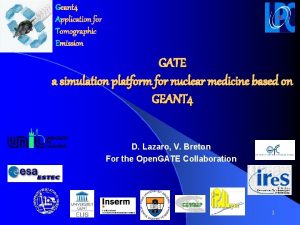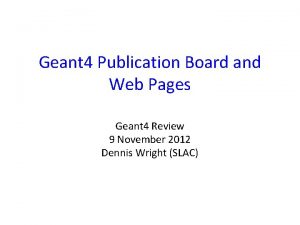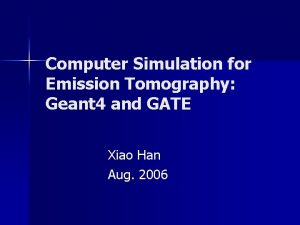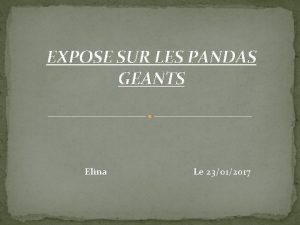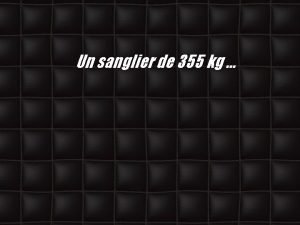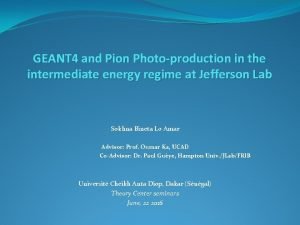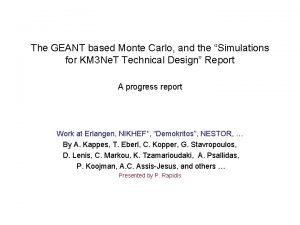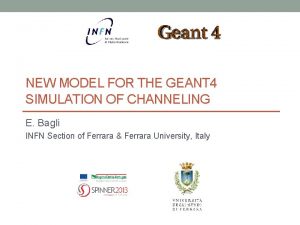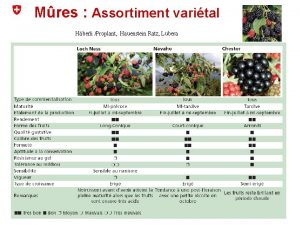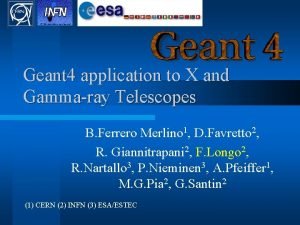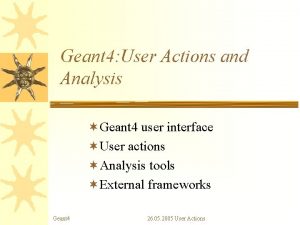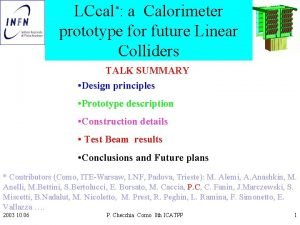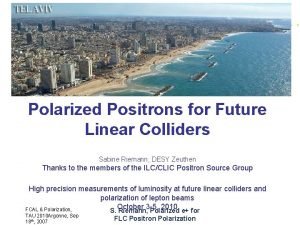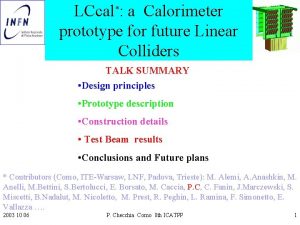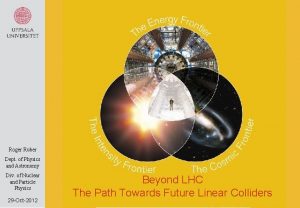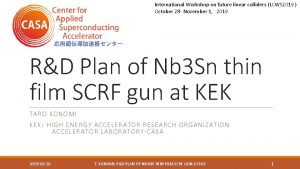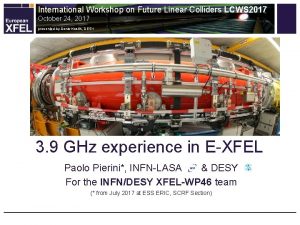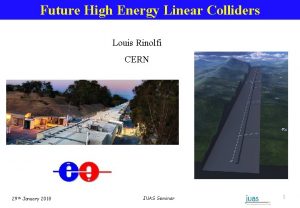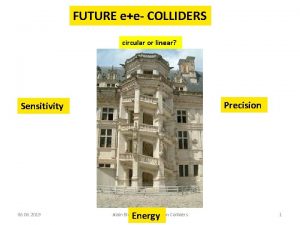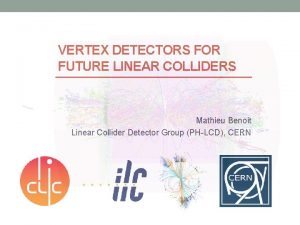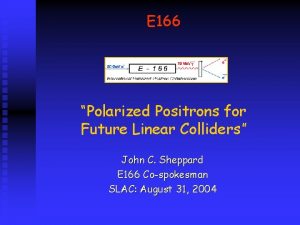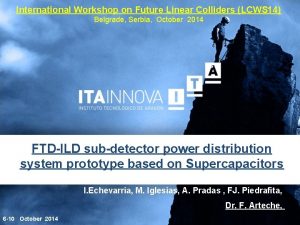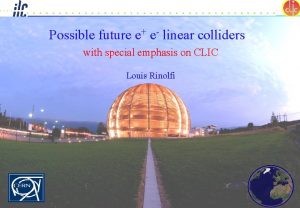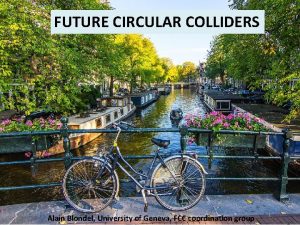GEANT 4 for Future Linear Colliders Geant 4























- Slides: 23

GEANT 4 for Future Linear Colliders Geant 4 Workshop @ DESY October 2, 2003

Linear Collider Environment n Exploit the physics discovery potential of e+ecollisions at s ~ 1 Te. V. n Precision measurements of complex final states require detectors with: Exceptional momentum resolution & vertexing. n Imaging calorimetry for “Energy Flow” analysis. n n Common simulation environment for all LC studies would allow sharing of detectors, algorithms, and code. n The system should be flexible, powerful, yet simple to install and maintain.

LC Detector Full Simulation MC Event G 4 Application Raw Event Geometry GEANT 4 Geometry Database Reconstruction, Visualization, …

Mokka n Geant 4 full simulation for the Tesla detector. n Uses subdetector-specific geometry drivers. Relevant parameters stored in My. SQL database. n Tight coupling between Sensitive Detector and geometry volume definitions. n n LCIO persistence for generic hits & MC chain.

The Proto 00 geometry driver P 55 MOKKA Proto 00 P 55 Ec

LCD Full Simulation n Geometry defined in XML. Flexible, but simplified volumes. n Projective readout of sensitive volumes. n n Dynamic topology, not just parameters. n Have defined generic hit classes for sensitive tracker and calorimeter hits. n Root and LCIO bindings for I/O.

TPC Tracker, Si Disks, CCD VTX

All Si Tracker, CCD VTX

Generic Hits Problem Statement n We wish to define a generic output hit format for full simulations of the response of detector elements to physics events. n Want to preserve the “true” Monte Carlo track information for later comparisons. n Want to defer digitization as much as possible to allow various resolutions, etc. to be efficiently studied.

Types of Hits n “Tracker” Hits Position sensitive. n Particle unperturbed by measurement. n Save “ideal” hit information. n n “Calorimeter” Hits Energy sensitive. n Enormous number of particles in shower precludes saving of each “ideal” hit. n Quantization necessary at simulation level. n

Hits Summary n Storing “ideal” hits gives detailed information about MC track trajectory. n Deferring digitization allows studies of detector resolution to be efficiently conducted. n Can approximate the same in calorimeter by defining small cells, then ganging later.

LCIO n Persistency framework for LC simulations. n Currently uses SIO: Simple Input Output on the fly data compression n some OO capabilities, e. g. pointers n C++ and Java implementation available n n Changes in IO engine designed for. n Extensible event data model Generic Tracker and Calorimeter Hits. n Monte Carlo particle heirarchy. n

LCIO (II) n Persistency framework for LC simulations. n Java, C++ and f 77 user interface. n LCIO is currently implemented in simulation frameworks: hep. lcd n Mokka/BRAHMS-reco n -> other groups are invited to join

LCIO Motivation LCIO Persistency Framework Generator Java, C++, Fortran Geant 3, Geant 4 Simulation Java, C++, Fortran Reconstruction geometry Java, C++, Fortran Analysis

Towards Internationalization n Suggest that Tesla, NLC and JLC full simulation groups could run a single GEANT 4 executable. n Geometry determined at run-time (XML). n Write out common “ideal” hits. n Digitize as appropriate with plug-ins. n Enormous savings in effort. n Makes comparisons easy.

Full Simulations LCD Full Sim GISMO C++ LCDROOT/LCDG 4 BRAHMS JIM GEANT 3 FORTRAN MOKKA Common GEANT 4 executable Runtime geometry Generic Hit output JUPITER

LCD/Mokka n First version of mysql / xml interface exists n SD detector fully modelled including beamline elements. n Several TESLA detector versions modelled. n LCIO output implemented in beta version. n Interfaces to HEPEVT and STDHEP and background files implemented. n Interface to AIDA integrated.

SD in Mokka

LC Detector Full Simulation MC Event (STDHEP) Histograms (AIDA) G 4 Application Geometry (XML) Database (My. SQL) (Generic Hits) (LCIO/Root) GEANT 4 Geometry Raw Event

Main Simulation Issues n Need n flexible method to describe geometry. Prefer G 4 supported geometry input (GDML? ) n Beam Delivery System requires arbitrary magnetic fields, excellent tracking precision. -5 Ge. V/c n Tracking System: (1/p. T) 5 x 10 (1/p. T) n Multiple Scattering, tracking precision. n Jet n Reconstruction: E/E~30%/√E Excellent hadronic shower simulations.

Highlights of LC Geant 4 Effort n Common n executable, with runtime geometry. Detector designs compared on equal footing. n Generic hits for trackers and calorimeters. Simplifies Sensitive Detector implementation. n Post-GEANT digitization design flexibility. n n Lightweight persistence format (LCIO). Allows interchange of data between communities. n Common target for Java, C++ & Fortran analyses. n

Why XML? n Simplicity: Rigid set of rules, plain text n Extensibility: Add custom features, data types n Interoperability: between OS and languages n Self-describing data n Hierarchical structure OOP n Open W 3 standard, lingua franca for B 2 B n Many tools for validating, parsing, translating n Automatic code-generation for data-binding

Why G 4 XML? n XML Schema very useful for “compile-time” type safety and bounds checking. n Prefer a G 4 -supported XML-based solution. Had hoped for common LHC solution. n Investigated GDML. n Looks promising. n Sensitive detector definitions needed. n Support? n
 Diferencia entre future perfect y future perfect continuous
Diferencia entre future perfect y future perfect continuous Future continuous and future perfect
Future continuous and future perfect Le géant atlas dans son café de bonsecours
Le géant atlas dans son café de bonsecours Renmap
Renmap Gate geant
Gate geant Pub geant
Pub geant Geant computer
Geant computer Exposé sur panda
Exposé sur panda Attila sanglier 355 kg
Attila sanglier 355 kg Pion geant
Pion geant Geant simulation
Geant simulation Geant 4
Geant 4 La plus grosse pelle mécanique au monde
La plus grosse pelle mécanique au monde Blatte rhinocéros
Blatte rhinocéros Geant 4
Geant 4 Myrtillier géant
Myrtillier géant Niconical
Niconical Action geant
Action geant Past continuous future
Past continuous future Future perfect future perfect continuous
Future perfect future perfect continuous Simple present past future tense words
Simple present past future tense words Future vacation
Future vacation Kondicional engleski
Kondicional engleski Future perfect and future continuous examples
Future perfect and future continuous examples




